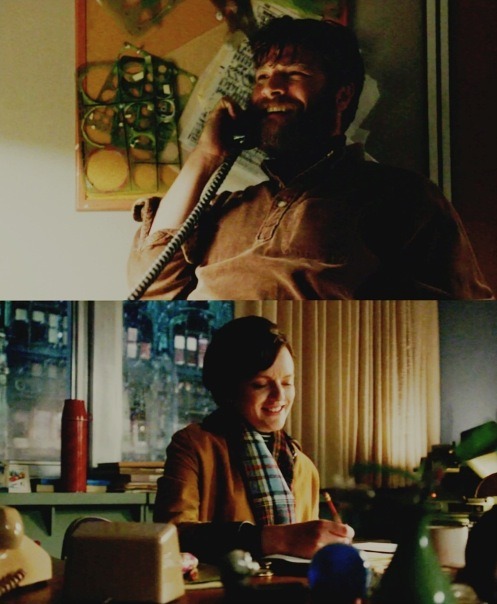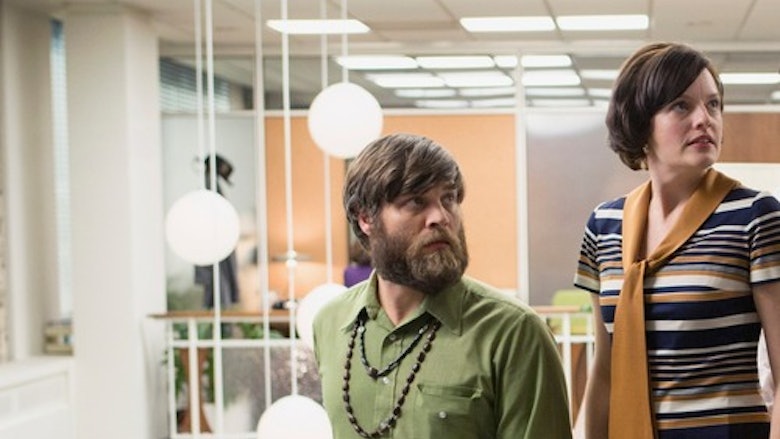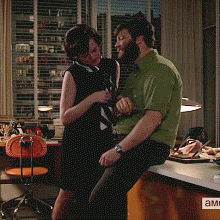Mad Men is not a show that attracts many shippers, perhaps partially because it’s the kind of show that fans and creators want to believe is “above” that kind of thing, but more likely because connections on the show are so fleeting and isolated. Romantic relationships tend to run their course, on-screen or off-, with little will-they-won’t-they tension, which might explain why many fans have become attached to the relationship between Peggy and Stan.
For years, Elisabeth Moss and Jay R. Ferguson have been bringing out the best in each other on screen. As Peggy and Stan, their scenes have been fascinating and exciting to watch, full of shifting dynamics and emotional vulnerability. They’ve stripped down in front of each other, literally and figuratively, and emerged at the end of the series with a more stable relationship than perhaps any other pair on the show.
Peggy and Stan’s relationship has been an enormous source of growth for both characters. Over the seasons, Stan has become less misogynistic, more open-minded. In turn, he brings out Peggy’s strengths and vulnerabilities, particularly in last week’s emotional confession. Peggy is able to admit to Stan something she’s never admitted to Pete: she made a mistake, she gave up her baby, she aches, she goes on. Stan recognizes Peggy’s pain without having it spelled out for him, gives her a chance to speak and a place to be vulnerable, gives her an apology that doesn’t pity or condescend. They end the episode on the phone in comfortable silence, strengthening and supporting each other in a way no other male-female pair on the show does.
Compared to the rest of Mad Men’s romantic relationships, this kind of health and growth is basically unheard of. Romantic pairings on Mad Men tend to be isolating and reflective. Don’s wives, girlfriends, and mistresses largely operate as symbols of things Don thinks he wants. Betty is respectability and old money, Bobbi is thrill and adventure, Faye is a challenge he considers but ultimately runs from, choosing instead to follow Roger’s disastrous model of marrying his young, beautiful secretary. In every case, we see the fantasy Don projects for himself, the life he imagines these romantic partners will mean for him, and we see the moment he becomes disillusioned with that fantasy. His relationships are not about the women he has them with, they’re about him and the image of himself he wants to present.
Joan’s relationships, on the other hand, are largely about the things she is denied. Roger won’t give her stability, Greg won’t give her autonomy, Bob won’t give her love, and her latest partner, Richard, expressed unwillingness to share her time and affection with her son. Every relationship represents a compromise, a way that Joan can’t have it all. She can be beautiful or she can be taken seriously; she can’t have both. It’s a continuation of every other story line Joan has had on the show, just as all of Don’s story lines have been about the man he thinks people think he is.
If we were to plot Mad Men’s characters on a graph, Peggy sits somewhere between these two. Like Don, she wants to create something that lasts, an image of herself that others will admire. Like Joan, she struggles between being respected as a professional and loved as a woman. Her relationships have fallen somewhere in between the two as well.
Her brief affair with Pete is a disappointment on every level. Her first year at Sterling Cooper is a jumble of advice coming from Don, Joan, Pete, and her family about how to be taken seriously, how to be found attractive, how to have a career, how to find a husband. Pete seems like promising help in many of these arenas. He’s willing to let Peggy sit in on creative meetings, he finds her attractive, and he comes from a good family, but this dream quickly falls apart as he becomes embarrassed of their relationship and jealous of her talent. Abe is the kind of rebellious idealist Peggy wants to be, but he doesn’t respect her work and doesn’t share her desires for a family. In the end, she finds he is not the type of person she wants to be or to be with. Ted seems like her perfect match on paper, appreciative and affectionate, someone who works in her field and understands her ambition, but he’s already married and is unwilling to destroy the life he’s already built to start over again with Peggy. Moreover, he doesn’t share her passion for their work.
In the beginning, Stan was no better. He did not take Peggy seriously, sexually or professionally. Earlier in the show, Stan is misogynistic and childish, flirting with secretaries, mocking Joan, trivializing Peggy’s emotions by constantly referring to her as sexually repressed or frustrated. He’s come on to Peggy several times over the course of the series, but never successfully and never particularly smoothly. His offers have been about “doing [Peggy] a favor” or needing comfort. Their office power dynamic feeds into this behavior, somewhat. Even a few weeks ago, Stan’s interaction with Pima Ryan proved that he’s still intimidated by powerful, self-possessed women who know their worth, and that he can still be gross in that moment of perceived emasculation.
His particular relationship with Peggy, however, has become incredibly respectful, both professionally and personally, without being sycophantic or false. She’s earned his admiration and he’s embarrassed himself in front of her so many times by now that he doesn’t have to posture anymore. Likewise, she’s become less rigid and less defensive. It’s easy to imagine the people they’ve become and the past they’ve shared evolving into a successful romantic relationship, where both continue to grow and challenge each other. They’ve both seen each other’s worst and it’s made them human for each other in a way no other romantic relationship on Mad Men has survived. Arguably, the reason their relationship has been allowed to grow and deepen in this way is because it has remained platonic, despite moments of sexual tension.
The show’s romances are tied up in presentation and status and respect in a way that its friendships are not, and friendship between men and women is rare. Romantic relationships, like everything else on Mad Men, become about aspirations in the end. Perhaps the show’s best chance for a couple with staying power is the duo who have already spent years becoming disillusioned with each other. Imagine if Betty and Don, so similar in so many ways, had been allowed to know each other intimately and completely, to see each other humans rather than symbols, before they married and had kids. From a modern perspective, it’s easy to see why audiences gravitate to Stan and Peggy.





This post is everything to me, also the relationships on MM remind one of "Pride & Prejudice" no? I also did this http://toongrrl.deviantart.com/art/Stan-and-Peggy-572306634
ReplyDelete